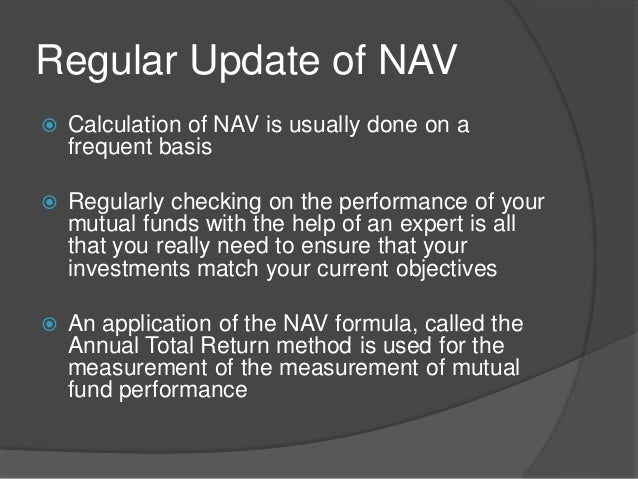Tracking The Net Asset Value (NAV) Of The Amundi Dow Jones Industrial Average UCITS ETF

Table of Contents
What is the Net Asset Value (NAV) and Why is it Important?
The Net Asset Value (NAV) represents the value of an ETF's underlying assets per share. For the Amundi Dow Jones Industrial Average UCITS ETF, this means the NAV reflects the total value of the holdings that mirror the Dow Jones Industrial Average, divided by the total number of outstanding ETF shares. Calculating the NAV involves totaling the market value of all the assets within the ETF (stocks in this case) and subtracting any liabilities. This figure is then divided by the number of outstanding shares.
Understanding the NAV is paramount for assessing your investment's performance. It provides a true reflection of the intrinsic value of your ETF holdings, unlike the market price which can fluctuate based on supply and demand. While the market price might temporarily deviate from the NAV, the NAV offers a more stable measure of the ETF's actual worth.
- NAV reflects the intrinsic value of the ETF.
- Market price can fluctuate due to supply and demand, creating short-term volatility.
- Tracking NAV helps understand true investment growth over the long term.
- Regular NAV monitoring aids in informed investment decisions.
Where to Find the Amundi Dow Jones Industrial Average UCITS ETF NAV?
Accessing the NAV of the Amundi Dow Jones Industrial Average UCITS ETF is straightforward. Several reliable sources provide real-time or historical NAV data:
-
The Amundi Website: This is the official source and usually offers the most accurate and up-to-date information. Look for the ETF's factsheet or dedicated data page.
-
Financial News Websites: Reputable financial news sources like Bloomberg, Yahoo Finance, and Google Finance often display real-time ETF pricing data, including the NAV. Search using the ETF's ticker symbol.
-
Brokerage Platforms: Most brokerage accounts provide detailed information on your investments, including the NAV of your held ETFs. This is a convenient way to track the NAV of your specific holdings.
The NAV is typically updated daily, reflecting the closing prices of the underlying assets.
- Check the ETF's factsheet on the Amundi website for precise details and updates.
- Use the ETF's ticker symbol (typically found on your brokerage statement) for searches on financial platforms.
- Consider using financial data APIs for automated tracking and integration into your investment management systems.
Interpreting and Utilizing NAV Data for Investment Strategies
NAV data is a powerful tool for monitoring the Amundi Dow Jones Industrial Average UCITS ETF's performance and informing your investment decisions. By comparing the NAV across different periods, you can readily assess growth or decline. For example, calculate the percentage change in NAV over specific timeframes (e.g., monthly, quarterly, annually) to monitor your investment's progress.
Further enhance your analysis by comparing the ETF's NAV performance to relevant benchmarks such as the Dow Jones Industrial Average itself. This allows for an accurate evaluation of the ETF's tracking effectiveness. Remember, using NAV in conjunction with other critical metrics, such as expense ratios, provides a holistic view of your investment's health.
- Calculate percentage change in NAV over different timeframes (e.g., monthly, yearly) to track growth or decline.
- Compare the ETF's NAV performance against its benchmark (the Dow Jones Industrial Average) to evaluate tracking accuracy.
- Use NAV to inform buy/sell decisions based on your investment goals and risk tolerance. Prioritize long-term trends rather than short-term fluctuations.
Potential Challenges and Considerations in NAV Tracking
While NAV tracking is generally straightforward, some potential challenges exist:
-
Delays in NAV Reporting: There might be a slight delay between the market close and the official NAV publication. This is more pronounced for less liquid ETFs.
-
Currency Fluctuations: If the underlying assets of the ETF are denominated in a currency different from your base currency, exchange rate fluctuations will affect the NAV.
-
ETF Composition: Understanding the ETF's holdings and their weighting is vital for interpreting NAV changes. Shifts in the composition can affect the NAV's trajectory.
-
Be aware of reporting lags, especially for less liquid ETFs. The Amundi Dow Jones Industrial Average UCITS ETF being relatively liquid minimizes this risk.
-
Consider the effects of currency exchange rates if the ETF had international holdings; however, this ETF primarily tracks the Dow Jones Industrial Average, a US-based index, minimizing this concern.
-
Understand the weighting of the underlying assets within the ETF to better comprehend the impact of individual stock performance on the overall NAV.
Conclusion: Mastering NAV Tracking for the Amundi Dow Jones Industrial Average UCITS ETF
Regularly monitoring the Net Asset Value (NAV) of your Amundi Dow Jones Industrial Average UCITS ETF is essential for informed investment decisions. This article provided a comprehensive guide to understanding NAV, locating reliable sources for data, interpreting the information, and addressing potential challenges. By utilizing the resources and strategies discussed, you can effectively track the NAV, understand your investment’s true performance, and make more confident decisions regarding your portfolio management. Start tracking the Net Asset Value of your Amundi Dow Jones Industrial Average UCITS ETF investments today for a clearer understanding of your portfolio's performance! Keywords: Amundi Dow Jones Industrial Average UCITS ETF, NAV tracking, investment performance, portfolio management.

Featured Posts
-
 Paris Economy Suffers Luxury Sector Decline Impacts City Finances
May 25, 2025
Paris Economy Suffers Luxury Sector Decline Impacts City Finances
May 25, 2025 -
 Kazuo Ishiguros Novels The Power Of Remembrance And Oblivion
May 25, 2025
Kazuo Ishiguros Novels The Power Of Remembrance And Oblivion
May 25, 2025 -
 Met Gala 2025 Naomi Campbells Absence Sparks Rumors Of Anna Wintour Fallout
May 25, 2025
Met Gala 2025 Naomi Campbells Absence Sparks Rumors Of Anna Wintour Fallout
May 25, 2025 -
 Angry Elon Is Back Good News For Tesla
May 25, 2025
Angry Elon Is Back Good News For Tesla
May 25, 2025 -
 Srbija Penzioneri Sa Bogatim Zivotom I Luksuznim Vilama
May 25, 2025
Srbija Penzioneri Sa Bogatim Zivotom I Luksuznim Vilama
May 25, 2025
